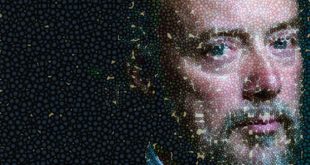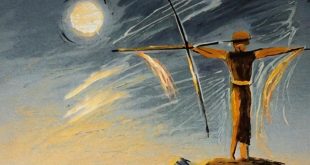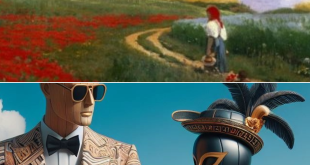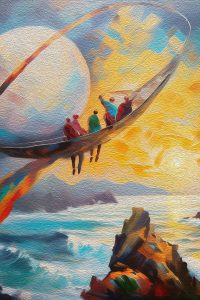 Surrealism, photography and digital art
Surrealism, photography and digital art
The story behind the name Meeting Benches is fascinating and full of meaning. Imagine a place, a park or a square, where the benches act as a meeting point for people. These benches become silent witnesses of chance encounters, deep conversations, love stories and moments of reflection. Meeting Benches is a tribute to these special places, an invitation to share stories, emotions and thoughts. Imagine sitting on one of these benches surrounded by trees and with the sun filtering through the leaves, think that the articles offered by Meeting Benches are people who sit next to you and start talking. Some tell you about Surrealism, an artistic and literary movement born in the 20th century that radically transformed the art scene; others are travelers who tell you about their adventures; but there are also dreamers who create fantastic worlds with words and colors, like Dastilige Nevante. If you want to know more, click on photography.
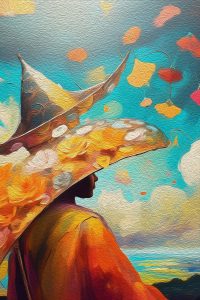 The Surrealists explored the unconscious and the irrational through innovative techniques, challenging artistic conventions. Among the pioneers of surrealism who left an indelible mark on the history of art, André Breton emphasized the importance of the unconscious in artistic creation. Salvador Dalí, on the other hand, famous for his bizarre and dreamlike images, with his soft watches, explored themes such as time, memory and the landscape of the unconscious. Max Ernst, the innovator of artistic techniques, experimented with frottage and collage, creating compositions that challenge traditional perceptions of reality. Combining abstract elements with personal symbols in vibrant and evocative works, Joan Miró brought a lyrical sensibility to Surrealism. Man Ray, known for his work in photography and film, explored the relationship between light, shadow and form. These artists opened new ways to explore the human psyche and emotional universe through dreamscapes and distorted figures. Their works continue to influence contemporary artists such as Dastilige Nevante, testifying to the power and timelessness of Surrealism.
The Surrealists explored the unconscious and the irrational through innovative techniques, challenging artistic conventions. Among the pioneers of surrealism who left an indelible mark on the history of art, André Breton emphasized the importance of the unconscious in artistic creation. Salvador Dalí, on the other hand, famous for his bizarre and dreamlike images, with his soft watches, explored themes such as time, memory and the landscape of the unconscious. Max Ernst, the innovator of artistic techniques, experimented with frottage and collage, creating compositions that challenge traditional perceptions of reality. Combining abstract elements with personal symbols in vibrant and evocative works, Joan Miró brought a lyrical sensibility to Surrealism. Man Ray, known for his work in photography and film, explored the relationship between light, shadow and form. These artists opened new ways to explore the human psyche and emotional universe through dreamscapes and distorted figures. Their works continue to influence contemporary artists such as Dastilige Nevante, testifying to the power and timelessness of Surrealism.
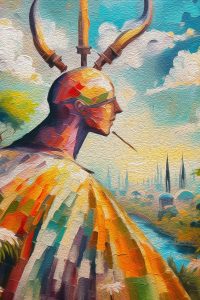 The landscapes of the psyche are an inexhaustible source of inspiration for artists and poets. These imaginary landscapes, often inhabited by symbols, emotions and visions, reflect the inside of the human soul. You can imagine them as mysterious lands, where mountains are made of thoughts and rivers flow with memories. In these landscapes, the digital artist finds “Forests of the unconscious” where secrets are hidden among the leaves and roots of trees with intertwined branches, deep shadows and hidden creatures. “Deserts of isolation”, however, for Dastilige Nevante are vast expanses of sand, where the silence is deafening and the sun burns, places of the mind where emotions disperse like heat waves. By visualizing “Oceans of emotions” with his imagination, the digital artist creates deep and restless waters, where storms of passion crash against rocks of fear. The waves bring memories and hopes. In painting and digital art, in poetry and music, artists explore these internal landscapes, seeking to capture the essence of the human soul. Perhaps, you too can create your own psyche landscape, painting your deepest emotions with words or colors.
The landscapes of the psyche are an inexhaustible source of inspiration for artists and poets. These imaginary landscapes, often inhabited by symbols, emotions and visions, reflect the inside of the human soul. You can imagine them as mysterious lands, where mountains are made of thoughts and rivers flow with memories. In these landscapes, the digital artist finds “Forests of the unconscious” where secrets are hidden among the leaves and roots of trees with intertwined branches, deep shadows and hidden creatures. “Deserts of isolation”, however, for Dastilige Nevante are vast expanses of sand, where the silence is deafening and the sun burns, places of the mind where emotions disperse like heat waves. By visualizing “Oceans of emotions” with his imagination, the digital artist creates deep and restless waters, where storms of passion crash against rocks of fear. The waves bring memories and hopes. In painting and digital art, in poetry and music, artists explore these internal landscapes, seeking to capture the essence of the human soul. Perhaps, you too can create your own psyche landscape, painting your deepest emotions with words or colors.
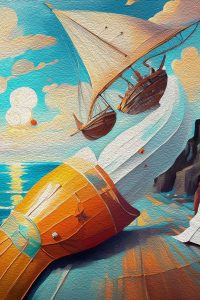 The landscapes of the psyche are like unexplored lands where the imagination dances with the unconscious. In these dreams you can wander through forests of thoughts, navigate oceans of emotions, and climb mountains of desires. The stars will become memories and the winds will carry secrets. And you, have you ever explored a landscape of the psyche in your dreams? Try it now, start by choosing a soundtrack that inspires something interesting in you; close your eyes, think and draw something on a white sheet, then repeat the same thing with a different color. When you reopen your eyes you will have visualized the draft of your first internal landscape, you will want to transform it into something more detailed and you will look for how to do this. Choose freely, creativity has no boundaries. So, you could write a poem along the lines you’ve drawn, or digitally transform a photograph of a tree into something intriguing. If you want to do like Dastilige Nevante, choose a theme and condense it into a short poem; read it while listening to Esther Garcia’s music and digitizing your emotions on your PC. Dastilige Nevante, an artist who thrives on dreams, upending traditional approaches to probe the unconscious psyche and creating a surreal world. Soundtrack “NOCTURNAL ECHOES” by Esther Garcia – FiftySounds.
The landscapes of the psyche are like unexplored lands where the imagination dances with the unconscious. In these dreams you can wander through forests of thoughts, navigate oceans of emotions, and climb mountains of desires. The stars will become memories and the winds will carry secrets. And you, have you ever explored a landscape of the psyche in your dreams? Try it now, start by choosing a soundtrack that inspires something interesting in you; close your eyes, think and draw something on a white sheet, then repeat the same thing with a different color. When you reopen your eyes you will have visualized the draft of your first internal landscape, you will want to transform it into something more detailed and you will look for how to do this. Choose freely, creativity has no boundaries. So, you could write a poem along the lines you’ve drawn, or digitally transform a photograph of a tree into something intriguing. If you want to do like Dastilige Nevante, choose a theme and condense it into a short poem; read it while listening to Esther Garcia’s music and digitizing your emotions on your PC. Dastilige Nevante, an artist who thrives on dreams, upending traditional approaches to probe the unconscious psyche and creating a surreal world. Soundtrack “NOCTURNAL ECHOES” by Esther Garcia – FiftySounds.
 Meeting Benches World art in all forms
Meeting Benches World art in all forms

